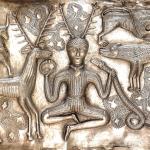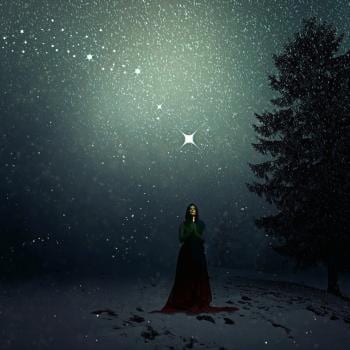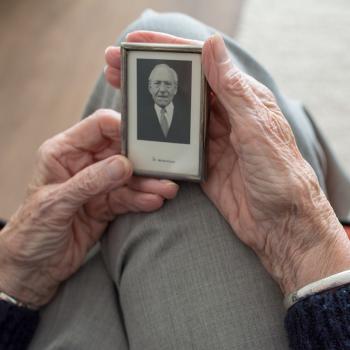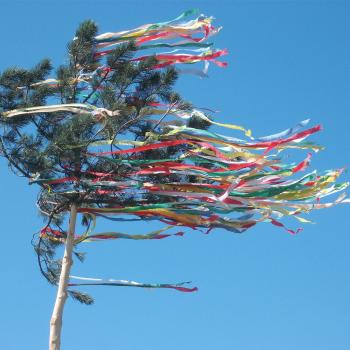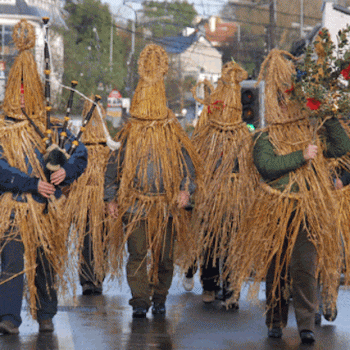It’s likely that you’ll participate in some form of Yuletide ritual this year. Perhaps you’ll swap gifts with someone you love or honor the Winter Solstice by extinguishing the candles in your house, only to light them again from the Yule log. Maybe your Yuletide features huge feasts and plenty of egg nog. It’s possible that you are the office party type, only participating in obligatory “secret Santa” exchanges and getting a little too tipsy at the Xmas lunch. I hope what ever you do, up to and including sitting the whole thing out, you enjoy it immensely.
I’ve discovered a few Yule traditions, celebrated in England and the British Isles, that didn’t quite make it to the modern day holiday.
Yule Revelry and Divination
An Entry in the Gentleman’s Magazine for 1784 by Mr. Mallet states “Among the Northern Nations was the Juul, afterwards called Yule, about the shortest day of the year.” The article further explains that Yule celebrations resembled the Roman Saturnalia and lasted just one day. The Yule day was replete with feasting and drinking and carousing. I’m a huge fan of carousing. It’s not done as much as it once was.
John Herolt, a Dominican monk of the mid fifteenth century, gave a sermon decrying the Yule celebrations of the common folk. He was most upset with persons who spent the whole night in drunken revelry and practicing divination by throwing salt and “other profane occupations”.
Salt divination, also know as Halomancy or Alomancy, is the practice of throwing salt crystals and then reading the patterns that they form. Not much remains today of the details of 15th century Halomancy, but the conjecture is that wise folk would read ridges as obstacles, and associate those obstacles with the months of the year. I’d be up for some salt divination after a night of drunken revelry, wouldn’t you?

Mumming In Drag
Why this tradition hasn’t survived to the present day, I don’t know. The story goes that men would wear the clothes of women and women would don the clothes of men. Then they would cad about town, making merry at each house they came to. The tradition has its roots in the Roman Saturnalia festival. The Synod of Trullus, written in 692 CE, expressly forbids mumming, as something “the faithful should not do.”
Public dancing by women and dressing as one another apparently led to “much harm and ruin” as it had been invented and observed as an homage to the heathen gods. However, some traditions just won’t die out, and men dressing as women is as English as steak and kidney pudding. Reports show Yule mumming still existed as late as 1905. I do have a theory that perhaps mumming in drag inspired the Christmas Pantomime, perennially popular in England.
So, this Yule, feel free to dress in drag…You know you want to!

Mother Night
This is just sweet. A contributor named Beckwith remarks in the 1794 edition of Gentleman’s Magazine that Mother Night was practiced by our ancient British ancestors. On the night of Winter Solstice, mothers would count off the number of Solstices they’d been alive, thereby fixing their age. Modern day astrologers would hate this because we’d all be either Sagittarius or Capricorn.
Personally, I can vouch for Sagittarius being the very best of signs. Capricorn’s ain’t that bad either. The Yule feasts would be epic and would last for days and then Sagittarians would tell ever increasingly tall tales about just how epic the parties were.
And Then There’s This One About Jolly St. Nick That I bet You’ve Never Heard Before
Henry Machyn (1496-1563) commented in his eponymous The Diary of Henry Machyn, Citizen and Merchant-Taylor of London 1550-1563 that – I’m just going to write this as he wrote it because I think it is fanstastic. My dear friend Pandora will love it-
The V. day of Desember was Sant Necolas evyn, and Sant Necolas whentt a-brod in most partt in London syngyng after the olde fassyon, and was reseyyved with mony by good pepulle in to ther howses, and had myche good chere as ever they had, in mony plasses.
Now at this point in history, the mid 16th century, the tale of Saint Nick was well known. He was a benevolent old chap who would drop off presents to the little girls and boys. Old Saint Nick would come upon a shut window and magically leave gifts by the chimney. Sounds pretty much like the tale we’re familiar with. The good little boys and girls fasted on the occasion of St Nicholas’s visit to show a humble and grateful attitude. Okay…I’d never heard that, but sure, I guess kids go to bed early on Christmas eve and that’s kind of like a fast, I suppose.
But then we learn – Alright, I hope you are sitting down for this – The story of Saint Nick and his generosity was purported, according to 16th century common knowledge, to spring from an older, legendary account.
It seems that Santa came upon a poor family with three daughters. Their circumstances were so dire, that the father was about to put his daughters out for prostitution. Father Christmas, apparently not a huge fan of child prostitution, popped by the man’s bedchambers at night. He secretly dropped off three equal portions of gold. The children, unaware of their impending employment, slept blissfully and dreamed of pears and nuts and apples and petticoats and shoes. In the morning, they awoke, and found presents. This, this cultivated the deep and abiding worship of Saint Nicholas we’re all familiar with, and the children were spared “wicked things taught.”
I’ll just leave you there to ponder that one.
Happy Solstice and a Merry Yuletide to you and yours!
Now…Where’s my dress and heels. I’ve got some mumming to do.

